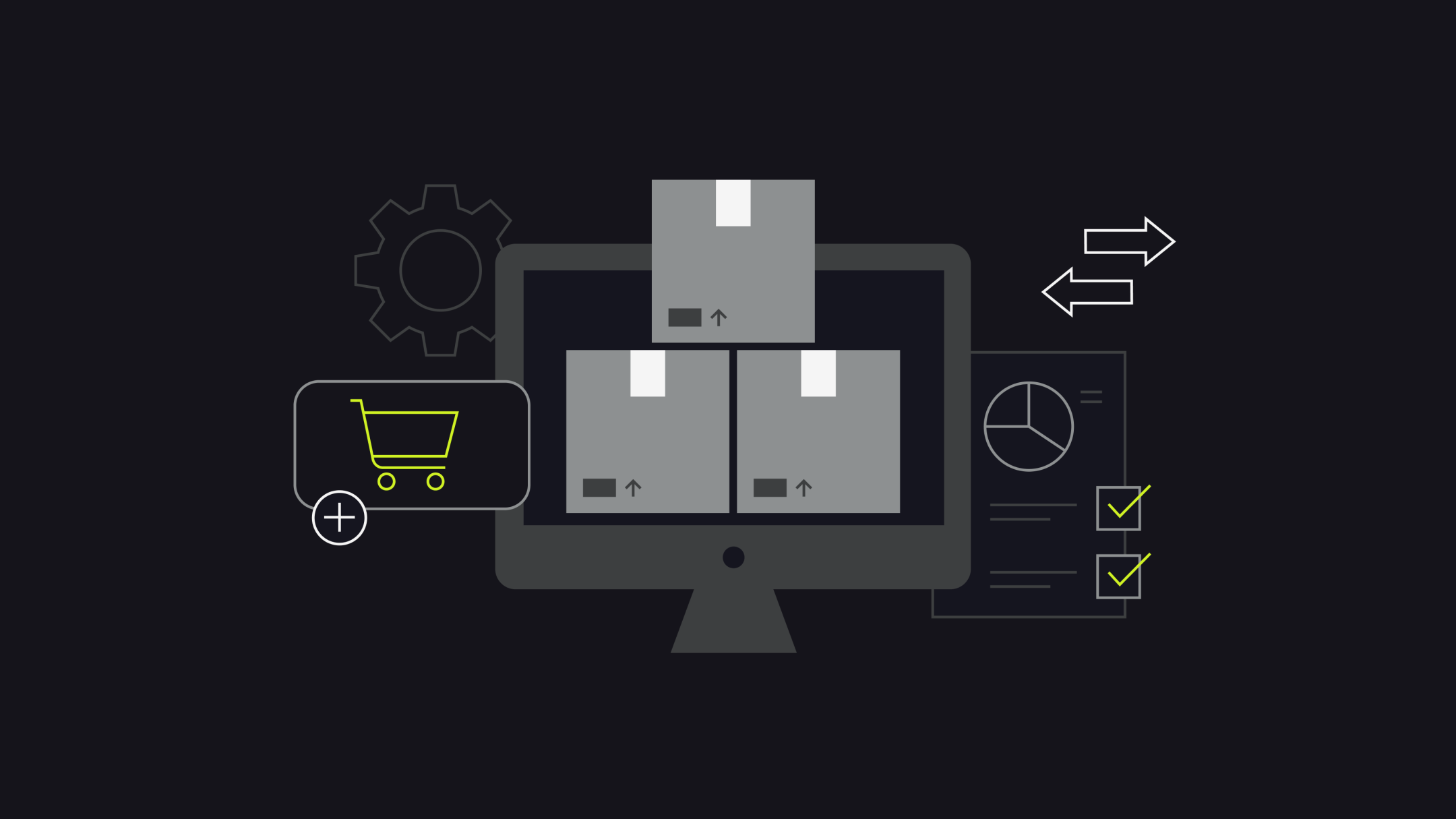Wholesale ecommerce refers to selling products to another business, in bulk and at a discount, online. This market is massive, totaling $13.09 trillion dollars in 2021 alone. Not to mention, B2B or wholesale ecommerce grew 1.17 times faster than the growth in all U.S manufacturing and distribution sales, with 15.2% year over year growth(Digital Commerce 360).
The benefits are clear: higher order volume, less time spent on manual entry and admin tasks. Becoming a wholesaler helps you expand into this huge market and find new revenue streams for your business.
So, how can you take advantage of the action? This guide will walk you through how wholesale ecommerce works, how to find an ecommerce platform, and tips for creating your B2B online store.
Table of contents
- How wholesale ecommerce works
- How B2B ecommerce helps wholesalers
- How to choose a wholesale ecommerce platform
- Wholesale ecommerce websites: Insights from 50 merchants and marketers
- Putting wholesale ecommerce together
- Wholesale ecommerce FAQ
How wholesale ecommerce works
The most common type of wholesale is between producers (you) and retailers. However, there are wholesalers who sell to other wholesalers, and wholesalers—like Costco, for example—who sell directly to consumers.
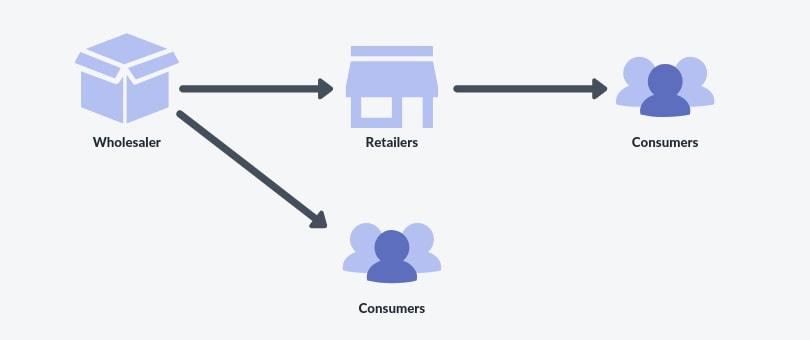
The most significant advantage of selling wholesale is that it lowers the cost of doing business. By selling items in bulk, you get to take advantage of larger orders and less marketing spend, which generally leads to making more money per unit. It also adds another channel to your sales mix.
The first thought that comes to mind about wholesale ecommerce is mega-sites like Alibaba. Wholesale is often thought of as a traditional sales channel with a less than ideal buying experience. But technology and changing B2B buyer behavior has driven a change in wholesale ecommerce.
Today, retail ecommerce businesses are selling wholesale to drive growth, without enormous capital investment or high risk. With the rightB2B ecommerce platform, merchants considering going into wholesale on a large or small scale can automate the process from signup to checkout, offer wholesale-specific pricing, and more.
How B2B ecommerce helps wholesalers
It’s long thought that B2B customers shunned digital channels. It’s true. Traditional wisdom held that buying wholesale was too complex to be conducted online, which is why so many suppliers haven’t made an investment in ecommerce just yet.
However, recent research fromMcKinseyreveals that the B2B buyer has changed. The availability of information through digital channels has made it easier for them to collect information independently. This means wholesalers have fewer opportunities to influence buyers’ decisions in person.
Technology likeB2B ecommerceplatforms have made it easier for wholesalers to sell online and to take advantage of the following benefits:
It simplifies the buying process
Wholesalers often feel ecommerce is not suitable for them because of the complex buying process. Concerns over contract pricing, product exclusivity, and customers with special terms and conditions discourage the adoption of ecommerce.
While these are valid concerns, the right wholesale ecommerce platform can help overcome these challenges and drive business growth. You can easily create a private B2B ecommerce website with all the information a client needs, rather than have them reach out for basic information.
The myth that a memorable purchasing experience matters—that’s false. The online experience for wholesale ecommerce websites should be as minimal as possible. Buyers want products that perform. Buyers have POs to enter and want the least amount of hiccups possible.
—Neil Stuber, Brand Manager at Hurraw! Balm
Ecommerce has also made it easier for buyers to find wholesalers and distributors online. When you optimize your website for search engineers, it helps potential buyers find you online faster.
It helps automates wholesale processes
Ecommerce automationis one of the biggest advantages of selling wholesale today. From signup to checkout, you’ll spend less time managing orders over the phone and email and more time on the strategic needs of your business.
Without a doubt, the biggest myth in wholesale is that the self-service ordering model used in retail won’t work in a B2B setting. As in retail, business customers benefit greatly from the time and effort savings of online ordering, in their own time, with full visibility of the status of their order.
—Ben Chidiac, Cofounder of Beard & Blade
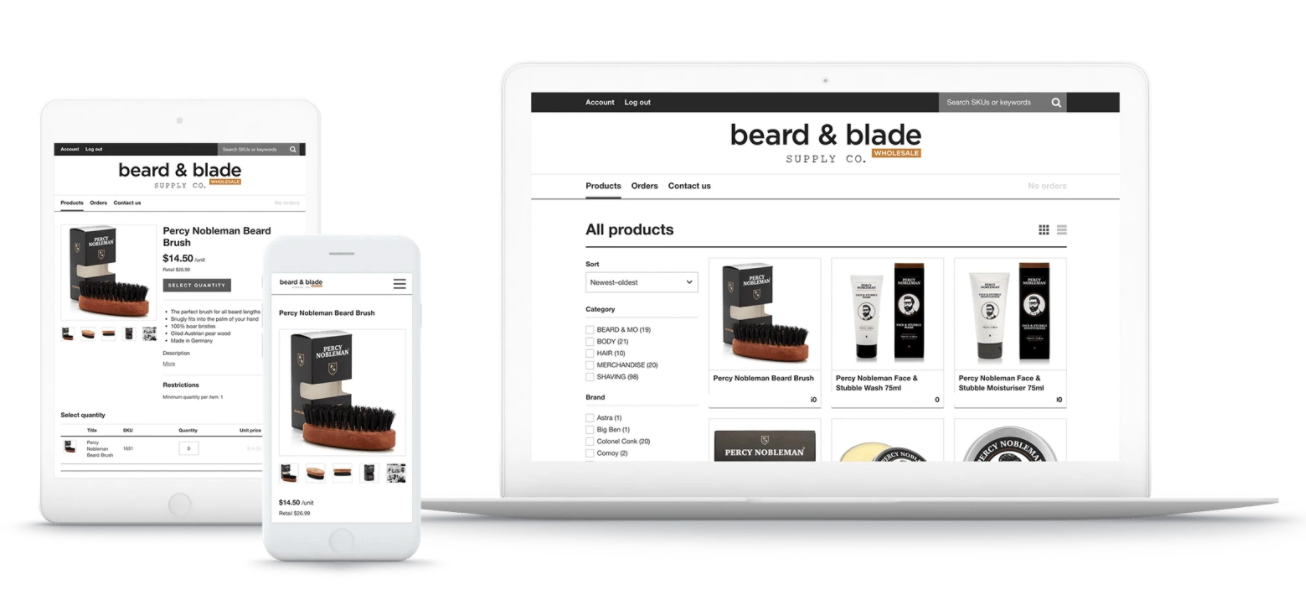
Ecommerce technology today, likeShopify wholesale, can help you:
- Create custom pricing and percentage discounts for specific customers or groups
- Automate and review customer signups
- Let customers purchase, track, and reorder products
- Review orders before invoicing
- Streamline inventory and order management
It improves the buyer experience
B2B buyers have come to expect the same service as their B2C counterparts. Buyers today are armed with information and don’t need to speak to a representative before purchasing. They prefer simple onboarding and ordering experiences. It's why Shopify wholesale offers features like a 24/7 customer accounts portal that customers can access without assistance.
Research fromDemand Gen Reportfound that 67% of B2B buyers want easy access to whole pricing. Another 64% of respondents required easy access to content without registration forms, while a striking 66% of buyers were influenced by websites that spoke to specific industry needs.
"Don’t think that your website should cater to all audiences. When you know your audience, tailor the experience to them to maximize profits for wholesale. This means understanding what features your customers really care about. Do they need the bells and whistles that the average consumer needs? Do they need interactive guides and tools to help them find the products, or do they just want a clean interface, straightforward pricing, and support when they need it?" —Jesse Teske, VP of Performance Marketing atThinkWarwick
Ecommerce can help wholesalers anticipate buyers’ needs. It can aid the buyers’ research process and guarantee they can easily access content throughout the buying process.
It increases sales while lowering spend
Selling wholesale online is the fastest way to speed up business growth. If you’re a manufacturer, selling in bulk can help raise product volume and lower cost-per-unit, which in turn helps your profit margin. Shipping in bulk to fewer customers can also lower fulfillment costs.
It helps enter new markets
Moving into a new country or territory comes with its own set of logistical challenges. You’ll also be marketing to a new audience that’s never heard of you.
When an established retailer teams up with your business, you can leverage its supply chain to reduce risk and lower setup costs. Wholesalers also save money on marketing by getting access to the retailer’s existing customer base.
How to choose a wholesale ecommerce platform
Here are some guidelines to follow whenfinding wholesale ecommerce platformsfor your brand:
Separate, password-protected wholesale websites
A separate, password-protected wholesale store is key when building yourB2B ecommercearm. Your wholesale ecommerce platform should make it easy for you to create a store. It should also be simple to add your products, create customer accounts, and create wholesale price lists.
Take Beard & Blade, for instance. On the brand’s B2C ecommerce site, you’ll find a wholesale link at the bottom of its homepage.
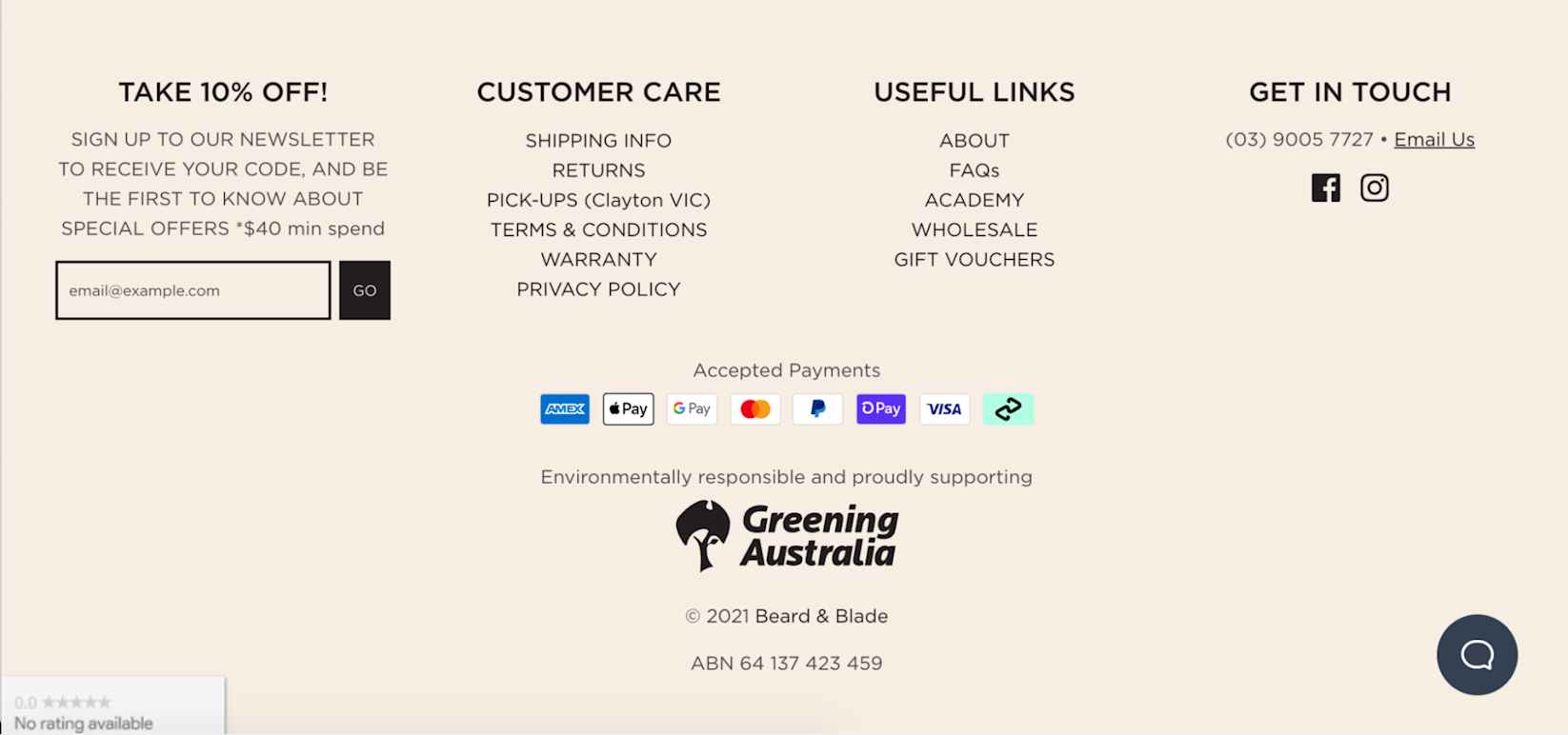
On its site, you can apply for a wholesale account and get access to your own sales portal.

一旦接受了,你将在为移动设备优化土地,B2B ecommerce store with custom pricing lists built for different customer groups.
Beard & Blade’s wholesale store runs on the same dashboard as its B2C store. Items for wholesale orders are pulled from one inventory pool and sync with all orders and customers for real-time tracking and analysis.
The brand’s password-protected website helps it control which customers have access to:
- 独家的公关oducts and collections
- Discounts
- Maximum and minimum quantity increments
Wholesale buyers benefit from the ease of ordering through Beard & Blade’s portal, on their own time, with full visibility into the status of their orders.
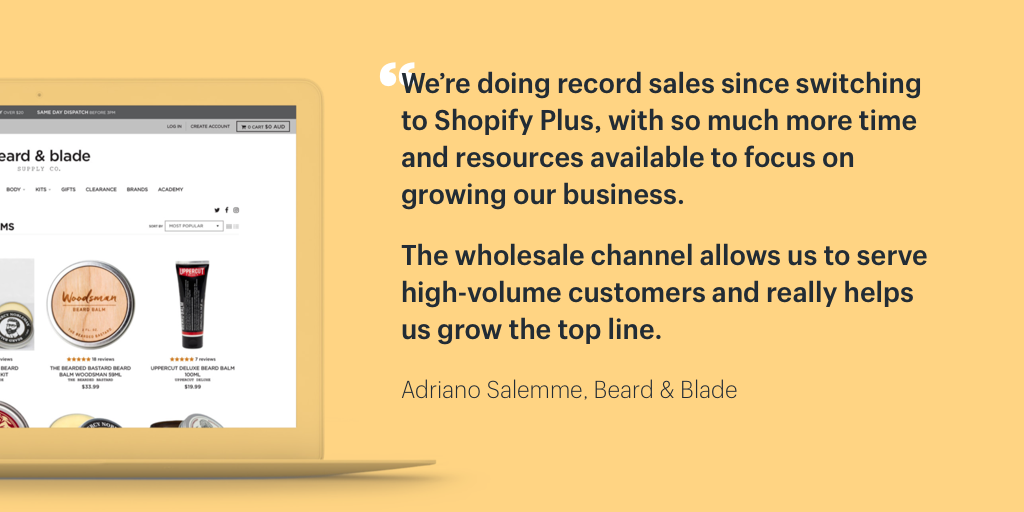
Good search functionality and catalog browsing
Site search is often the most overlooked function of a wholesale ecommerce site. Effective search functionality means better usability, which helps buyers find items faster. The easier buyers can find products, the more likely they are to place an order.
Take The Elephant Pants wholesale portal, for example. The brand includes a number ofB2B ecommerceelements, such as accessible search bar, an extensive catalog for browsing, and clear pricing.
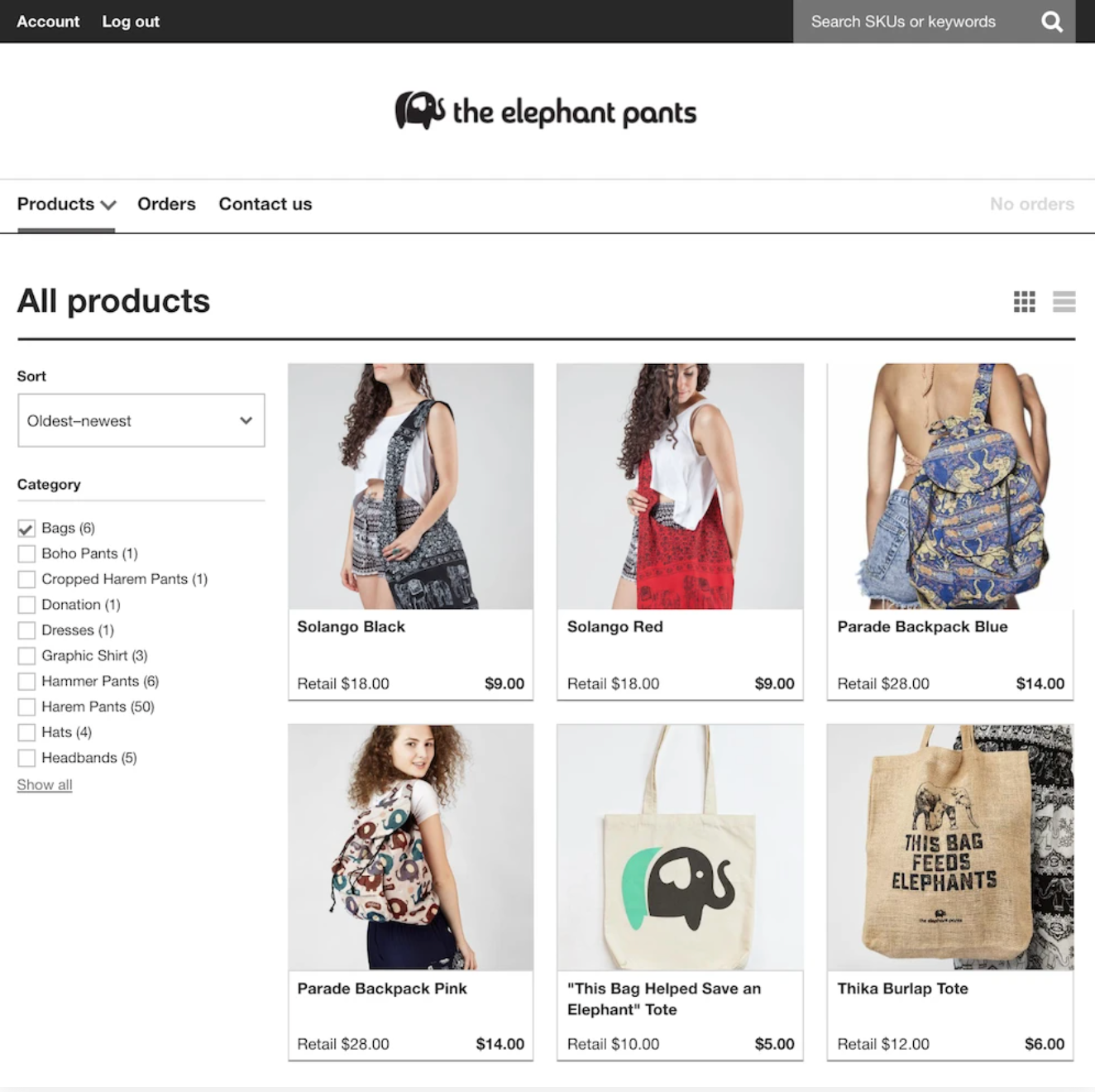
According to The Elephant Pants CFO and founder James Brooks, between 80%–90% of buyers create their order through the wholesale channel. Terms are determined on a buyer-to-buyer basis, which has resulted in wholesale as a key sales channel for the brand.
Integrations and flexible APIs
Integrations are the secret to a successful wholesale ecommerce store. Setting up an easy-to-use sales portal is the cost of entry, but integrations will take you to the top.
A good wholesale ecommerce platform will let you:
- Create custom storefronts and experiences
- Integrate with existing systems like an ERP or CRM through a flexible API and SDK
- Connect your business tools with ecommerce automation
- Automate everything from simple tasks to complex workflows
Choose a platform that has a reliable API and developer tool releases. Look for a platform that gives you unlimited development environments so you can test store changes before sending them live.
Optimized for search and content marketing
B2B与B2C买家当我买家没有不同t comes to finding solutions. Both groups search through Google to find the right supplier that meets their needs. The difference is that B2B buyers won’t land on a product page and checkout with their credit card straight away. They have to sort through logistics, have a few board meetings, and consider storage facilities before committing to a supplier.
This is why it’s important to find an ecommerce platform that's optimized for search.
SEO is a goldmine for B2B, and in many niches, it’s significantly less competitive than B2C. Many of the top brands haven’t invested a dollar in SEO because they haven’t had to. For example, I recently helped a B2B chocolate company hit number four for their top keyphrase, overtaking heavyweights like Lindt and Godiva…in a single month.
—Jacob McMillen, SEO and Content Strategist
Some search-friendly elements to look for are:
- Apps and plugins to help with SEO
- Optimized product and collection pages
- Content marketing capabilities like blog hosting and FAQ pages
A lot of B2B and wholesale ecommerce websites get caught up in being data-driven to succeed. You should be data-informed, but today’s shoppers find your product in so many different ways from so many different channels that you can succeed quite well by top-of-funnel and brand awareness alone.”
—Kevan Lee, Director of Marketing at Buffer
Wholesale ecommerce websites: Insights from 50 merchants and marketers
批发和B2B电子商务是t爆炸……une of $7.7-trillion this year. The advantages of investing in awholesale ecommerce platformcontinue to mount: higher average orders, conversion rates, and customer lifetime values.
With all those big numbers, two questions remain:
- What are the wholesale ecommerce myths?
- What are the musts?
To find answers, I reached out to a who’s who of online merchants, marketers, and influencers. 50 experts weighed in. So, to make this more easily digestible, here’s a breakdown of the six major areas we’ll examine below:
- Wholesale & B2B ecommerce
- Social media and influencer marketing in wholesale ecommerce
- Wholesale and B2B content marketing
- Wholesale lessons from B2C ecommerce
- Search engine optimization for wholesale
- Wholesale conversion rate optimization
Wholesale & B2B ecommerce
Ben Chidiac, Co-Founder of Beard & Blade

“Customer onboarding is essential to the success of B2B ecommerce to build trust in the system. That involves not only training about how to use the new system but ensuring that things like pricing, delivery addresses, billing information, and so on is entered into the system before they begin ordering.”
Neil Patel, Co-Founder of Crazy Egg, Kissmetrics and Hello Bar

“The biggest myth in wholesale is that merchants can ignore seasonal buying trends like Black Friday Cyber Monday after the initial B2B pre-season rush. Many wholesale businesses get caught unprepared for traffic, transactions, and inventory spikes during the holiday season itself.”
Louis Columbus, Director at Global Cloud Product Management & Enterprise Software Strategist at Forbes

“最常见的神话在B2B和批发易康姆ce is that a catalog is all that’s needed to succeed. In reality, having the ability to create buyer-centric journeys, supported with contextual content, is critical.
“Know how, why, and at what speed your customers buy. Understand that there are many sales you aren’t making because your ecommerce strategy needs to deliver an excellent experience regardless of the channel being used.”
Simon Slade, Founder, SaleHoo.com
“One of the myths about wholesale ecommerce is that you need loads of cash to get started. While you do need some startup money to break into the wholesale market, there are ways to scale your growth. For example, reorganize your existing space to make room for your bulk products rather than renting a new storage space right off the bat. And don’t forget to negotiate with your suppliers—they tend to be more flexible when you’re making a large order.
“When it comes to wholesale, relationships are everything. This means that your customer service has to be more than just above average—it has to be out-of-this-world. Customer service is the foundation for building excellent relationships with your customers, so make that foundation strong and impressive.
Ultimately, you’ll be better off competing to have the best customer service than trying to have the most affordable products.
“Focus your energy on providing well-trained customer service reps and lots of perks.”
Renzo Costarella, Business Development at Flint
“The number one myth is that businesses only want to buy with credit cards when, in reality, they like to use many types of payment options.
“You need to have multiple payment methods, including ACH/e-check, debit and credit, digital wallet, email/text payments (P2P), and even cryptocurrency.”
Social media and influencer marketing in wholesale ecommerce
Sam Hurley, No. 1-ranked digital marketer & Founder of OPTIM-EYEZ

“The number one myth has to be, ‘But we don’t need social media,’ or, ‘Social media isn’t relevant to our business.’ As a B2B brand, there are always clever and highly effective marketing tactics to be deployed via social networks.
“Use LinkedIn and Twitter to build an authoritative, active, and personal brand. The tight relationships that employees and executives can forge on social media are truly impactful, leading to many sales opportunities—in addition to the possibility of partnerships and countless other business ventures. Harmonize this with offline activities such as trade shows and you’re onto a winner!”
Brian D. Evans, Inc. 500 entrepreneur & Founder of Influencive
“There is a myth that marketing must be extremely direct. Influencer marketing works on a broad range of products and services because they are influencing a buyer’s decision.
Associate with other credible brands and influencers through strategic alliances.
“Brands need to do this more in the B2B space. It’s the number one most commonly underutilized and insanely valuable way to leverage more sales.”
Rachel Pedersen, CEO of RBP Productions & Managing Partner of InfluenceTree

“One of the biggest myths in B2B ecommerce is that you need to be stiff or boring. B2B just means that you’re working with a business…but you are still connecting with people. They just happen to be the decision makers within businesses.
“The number one must in B2B ecommerce is creating a brand that people want to connect with. Make it funny, cheeky, snarky, educational, entertaining—anything—as long as you aren’t boring.”
Travis Hawley, VP of Business Development at Viral Nation

“Quite frankly, influencer marketing in the B2B world is non-existent or—at the very least—far less popular and mature than it is in the B2C world. The answer must be experimentation, testing, and optimization.
“Start by approaching B2B products and services with a B2C emphasis. When over one billion Yahoo accounts were hacked in 2016, news of ‘ransomware’ was suddenly everywhere, and consumers were pressuring traditionally B2B providers to beef up their security. In that climate, tech influencers the public would otherwise ignore were thrust into the spotlight. Those types of influencers exist in every industry and can be powerful content-distribution hubs for brands.
“Still, there’s no better way to get your products into the stores of retail partners than by creating a groundswell of demand among consumers. If consumers care, businesses listen.”
Tim Hughes, Co-Founder at Digital Leadership Associates
“My customers are not on social, and the only way to reach them is through paid advertising and ‘interruption’ marketing. Even in B2B, that’s not the case.
“Because people don’t believe the claims of companies and with the 30% year-over-year rise of ad blockers, the traditional ad world will soon die. Advertising is not social and social is not advertising. Social is sharing useful content that sparks real conversations with the people you’re trying to reach.”
Murray Newlands, Forbes and Entrepreneur magazine contributor

“The myth is that businesses don’t want to create a relationship with the businesses they buy from, but they want brands to create special experiences for them.
“You need to have a chatbot that can be available to engage with customers around the clock and whenever customers want to buy but have a question. That will increase the number of transactions.”
Brian Burt, Founder & CEO of Canopy Brands
“When it comes to influencer marketing and ecommerce, the potential is nearly unlimited. However, many sellers don’t believe they have an influencer in their niche—which is totally untrue. Even the weird and quirky products have influencers that can help you get the word out and move product.
In the rare case that there truly is not an influencer in your niche…then you’ve found the golden opportunity to become the influencer.
“B2C and B2B are remarkably similar in the fact that your end prospect needs to know, like, and trust your brand before they will ever make a purchase decision. As a business owner who serves both, build a real and sustainable brand first. The rest will fall into place.”
Goldie Chan, Founder of Warm Robots

“When you are B2C, you have the luxury/ability to market to a much broader audience, because your brand can have general mass appeal. For B2B and wholesale ecommerce, it’s important to lock down your buyer personas and heavily target those—either with special landing pages or dedicated paid ad campaigns.
“On social, build relationships. If you aren’t building and speaking to your specific audience and buyers on a regular basis, social proof will not help sell as much as you might think. Speaking on a regular basis to your direct customer base or a targeted set of buyer personas will get you much closer to sales and profit.”
Wholesale & B2B content marketing
Jeff Bullas, Founder and CEO at Jeffbullas.com

“The number one myth is that the content cannot be interesting. You just need to be able to be creative and learn the art of storytelling.
“Create content that adds value to the target audience. Write and create content that solves problems and educates the potential buyers.”
Shayla Price, B2B content and email marketer
“ob欧宝娱乐app下载地址营销人员相信B2B组织don’t need or desire a personalized shopping experience. This myth limits our thinking, and ultimately we miss the opportunity to earn more sales.
“To personalize the B2B experience, focus on satisfying the needs of multiple stakeholders within the company. You can accomplish this task by creating worthwhile content that addresses their individual concerns. That way, the entire team sees your product as their solution.”
Robert Rose, Chief Troublemaker at The Content Advisory & Chief Strategy Adviser at Content Marketing Institute
“Companies need to figure out how to transform what they do from commoditized service into differentiating experience. Content-driven experiences can add this differentiated value.”
Kevan Lee, Director of Marketing at Buffer
You don’t have to do Facebook ads. Sure, they work great for some, but at the end of the day, they are just one of many channels, and you’ll have specific channels that work well for you and your unique business.
“The must: give something away for free. Whether that’s top-of-funnel resources, free shipping, or generous customer support…whatever you can do to add to the value of the thing someone is buying, people will be very open, appreciative, and incentivized to buy.”
Giuseppe Caltabiano, Senior Director of Marketing at Rock Content

“The leading misconception is that B2B buyer’s journeys are so complex that, instead of creating online content tailored to each persona, companies should focus exclusively on training their salespeople.
“While it can be challenging from a budgetary and resource standpoint, B2B still needs to create content for the entire buyer’s journey at every stage of the funnel. Persona simplification through job titles and departmental profiles is the best way to go.”
Heidi Cohen, Chief Content Officer at Actionable Marketing Guide

“The top myth about B2B ecommerce is that you need a dedicated salesperson or team. To succeed, you must provide sufficient information that your customers and influencers need to select your firm.
“To this end, provide multiple entry points and allow for different consumption paths.”
Wholesale lessons from B2C ecommerce
John Rampton, CEO & Co-Founder of Due
“最大的误区是,你不需要一个直觉ive website because it’s really only consumers that shop through their mobile devices.
“In reality, businesses shop on mobile as well. You need to have a website that works for mobile devices and loads nearly instantaneously so a business owner can buy and move on with their busy day.”
Jesse Teske, VP of Performance Marketing at ThinkWarwick
“Focus on customer segmentation to understand your customers’ needs, and then deliver on those needs. The best way to do this is to grab demographic and behavioral data through the tools you have available. If you don’t have a lot of customer data available, consider running a contest. If you can implement progressive forms, you’ll continue to learn information about your customers or potential customers that you would not get elsewhere.”
Tomer Tagrin, CEO at Yotpo

“There’s a myth that user-generated content doesn’t matter in wholesale or B2B. In reality, customer content is the cornerstone of all ecommerce marketing activities—from SEO to paid acquisition and more. Every part of the customer journey today is impacted by customer content, and this will only be truer in the future.
“It’s a must not just to collect customer reviews and photos, but to use them throughout the buyer journey. Customer content improves organic traffic as well as CTRs on social and Google Ads. Plus, it offers a wealth of data that you can use to better understand your shoppers to build a stronger brand that truly caters to them.”
Andy Crestodina, Strategic Director of Orbit Media Studios
“Visitor psychology in B2B and B2C are different. Not true. All humans have cognitive biases, especially social proof. B2B products may not have as many reviews as a B2C site, but that doesn’t mean you can’t use testimonials on the product detail page.
“The ideal testimonial addresses a fear or anxiety that the potential buyer might have. Will I get this on time? ‘Thanks for the quick delivery!’ Do they offer support? ‘Your team was so helpful when I had issues.’
“Agreat testimonialcan also give you a nudge in search. Just make sure it includes the target phrase for that product. If you do, you've added social proof that can increase both traffic and conversions.”
Andrew Youderian, Founder of eCommerceFuel
“Don’t make the mistake of thinking people will buy wholesale from you if you have a wholesale site or program. That’s just table stakes! To really do well with wholesale ecommerce and B2B you need to invest in a marketing and outreach program to convince businesses and purchasing departments that you’re the best place to buy from.
“Make sure you have a process that makes it simple to provide quotes and bids, accept POs, to make the purchasing agent’s job as easy as possible. If you do, you’re much more likely to earn the customer and keep them long term.”
Linda Bustos, Co-founder of Ecommerce Illustrated

“Our customers don’t buy online. Many B2B companies erroneously believe customers want to use the channels they’ve always been using (offline/personal sales), and sales teams are often worried about cannibalization. If your competitors are online, your sales orgs are already threatened by digital, and they’ll eat your lunch if you don’t offer your customers the buying channels they want.
“It’s very important to work out your detailed business requirements before choosing or building out your ecommerce solution. B2B often requires tiered pricing, bundling, product configuration, multiple catalogs, and a degree of personalization by customer type. Make sure your solution partners are fully briefed on what your solution needs before the project is estimated and delivered or it will be very painful and costly to correct.”
Chad Rubin, Founder of Think Crucial & Skubana
“Invest in a smartinventory managementand operations solution that integrates both B2B and B2C. Wholesale usually has plenty of stock to coordinate, and you can’t afford to lose track of it by using fragmented applications.
“Once you miss a delivery and oversell stock you don’t have, or otherwise make a client mad, you aren’t just losing the business one time, you’re losing the continuity of the potential re-orders as well. There is no room for mistakes here.”
Nick Eubanks, Founder of From The Future
“Thanks to Amazon, the expectation is often that to be competitive you must offer free shipping. At Traffic Safety Store we sellveryheavy products, and free shipping is simply not possible—B2B buyers purchasing directly from manufacturer or supplier understand this as long as it is communicated clearly.”
Jake Rheude, Director of Marketing for Red Stag Fulfillment
“Myth: Same-day fulfillment is only for B2C. On a wholesale ecommerce website, the person behind an order is used to (and expects) two-day shipping for all their personal online orders. Why should they expect anything less when ordering products for their business? Order fulfillment processes should meet, if not exceed, the expectations of your customers.
“Must: Customer support is critical. If you receive a call or email inquiring about the status of an order, your warehouse management system had better be able to provide a detailed explanation of the order’s status. Whether your customer is waiting on a critical part to fix a machine or the desk for a new employee starting next Monday, a lack of detail in the order status can cause serious issues.”
Ed Leake, Managing Director of Midas Media

“Limiting payment options toeitherimmediate or invoice-only can hurt sales.
“Offering a finance option (where you outsource the risk) is an effective way of increasing conversions and, perhaps more importantly, raising average order sizes and repeat business. But offering a variety of options is a must.”
Jessica Goerke, Performance Advertising Manager at Gorilla 360
“Myth: Selling online will negatively impact your brand identity. When you’re running your own ecommerce website, you have control over the way customers perceive your brand. You can personalize product copy, pricing, the layout, everything.
“Wholesaling means you lose control of all these features. It’s a trade-off. But your brand identity doesn’t change. Your brand identity belongs to your business.
Be helpful. Always give superior service. As ecommerce professionals, we strive to build lifetime loyal customers.
“The best way you can optimize your ecommerce wholesale is always to have a helpful customer service contact. This may be in the form of a help desk, a contact number, or live chat.”
Chirag Kulkarni, Co-founder of Medly Pharmacy
“‘Since my customers are businesses, they don’t care how my site looks. I can keep my bulky site that I created 15 years ago.’ Absolutely myths.
“Ditch the B2B catalog site and take inspiration from B2C sites that create deep customer experiences.”
Shane Barker, Digital Marketing Consultant
“The most common myth is that B2B customers won’t shop online, so there’s limited growth potential. In truth,B2B ecommerceis experiencing massive growth and drives much higher revenue than B2C ecommerce.
“Although steps like customer segmentation, SEO, content marketing, etc., are still crucial, I think every business should focus on optimizing their website to improve the user experience. Your website is your virtual storefront, so you need to make sure visitors can easily navigate it to find what they need. That’s true whether you’re selling your goods/services to individual consumers or to other businesses.”
Search engine optimization for wholesale
Jacob McMillen, SEO and Content Strategist

“While ranking a landing page is typically more challenging than ranking a blog post, there are three things you can do to immediately improve the rank of any page.
Thefirst stepis on-page optimization:
Include the target keyphrase in the meta title and descriptionandthen optimize both for human click-throughs.
- Include the target keyphrase in the first 100 words and in at least one subheading.
- Reference the target keyphrase and similar word variations (LSI keywords) several times throughout the page.
“Thesecond stepis to find ways to expand the word count of your landing page without harming the conversion rate. There are a number of ways to do this:
- Expand landing page sections with more information.
- Add additional sections that dive into more detail.
- Add essentially a blog post after the final CTA that continues discussion of the product or its application.
“Thethird stepis link building, and while everyone seems to understand external link building, many B2B businesses don’t realize that internal link building can be incredibly powerful as well, particularly for established sites with a decent domain authority.
“Internal links are how you tell Google where to channel your website's authority. I like to add 10 internal links whenever I publish or update a client post or page, and it significantly increases the speed with which these pages rank.”
Bernard Huang, SEO Specialist
“The most important part of any ecommerce site is technology. Not true, it's about distribution channels and market positioning.
“重要的是要拥有自己的内容(例如,专业duct descriptions, photos, reviews) and distribution channels. Don’t give Amazon all your unique content.”
Amanda Gant, Marketing Director at Orbit Media Studios
“When it comes to wholesale product pages or B2B ecommerce in general, don’t overlookon-page SEO.Google wants the user to be happy. The only way they know how to measure ‘happiness’ is through engagement: SERP click-throughs, how long people are staying on your site, how many pages they visit, etc.
“Each page needs unique title tags and meta descriptions. This is the first thing a user sees when they search for your product or service. To Google, it indicates that the page is relevant for that search phrase. Meta descriptions are not a ranking factor, but they are crucial in getting users to click through to your site.
“Once you get the user to your site, continue to indicate relevance by including the topic or phrases in your header tags (H1–H3), page content, and links from other pages on your site to that page in particular (i.e., internal linking).”
Mark Hayes, Director of Communications at Shopify

“Just as you shouldn’t use the manufacturer product descriptions in B2C, don’t phone in yourowndescriptions on a wholesale ecommerce website. Building your product database can be a time-consuming process, and in an attempt to save time, many online store owners simply copy and paste product descriptions.
“This is an SEO no-no! Rewrite every single product description to ensure that it is unique, search engine friendly, and specific to wholesale.
“The same goes for product images. Wholesale sites need to addwholesale-specifickeywords into the alt tags of every image. For optimal effect, make sure that every keyword
Vlad Mkrtumyan, Partner at Logic Inbound
“A common myth we see is owners assuming they know which keywords to rank for. The words sellers use to describe their products don’t always match the search terms customers—even wholesale customers—are using to find them.
“A white-label lighter company, for example, wanted to rank for ‘logo lighters.’ After some straightforward research through Ahrefs, it became clear that ‘custom lighters’ had a much higher search volume. Even better—once we’d optimized—it also had a much higher conversion rate.
“Test your metrics constantly. Attribution is key. Use tools such as Ahrefs, Accuranker, or even Google Analytics to measure your rank and keyword-based conversions. Those will ultimately point you in the right direction. Numbers don't lie.”
Dan Shure, SEO Consultant and Podcast Host
“The biggest mistake I see is a lack of clarity on transactional vs. informational keywords, and trying to target something too broad and high volume—i.e., ‘espresso makers’ (informational and too broad) versus ‘espresso makers for wholesale’ (more specific, realistic, and transactional).
“Actually use the term ‘wholesale’ in your keyword targeting. This will not only get you in front of the right buyers but will also set more realistic expectations for search volumes in your keyword research.”
Wholesale conversion rate optimization
Peep Laja, Principal at CXL Institute

“你不能在网站上发布价格。这是nonsense. B2B people are still people—talk to them like normal human beings.
“Other than that, to become a good optimizer in B2B, wholesale, or anywhere, you have to start by accepting that your opinion doesn’t matter and that you don’t know what will work. If there’s anything I’ve learned in this business, it’s that opinions don’t make money.”
Johnathan Dane, Founder of KlientBoost
“People think that it’s a long, exhausting process to generate conversions in this space.
“Focus on the smaller asks first. If you want to succeed quickly, then understand the temperature of your prospects, and how something like the breadcrumb technique can help you get your prospects to take the first step to communicate with you before you go for the sale.
“It’s all about courting now instead of the usual B2C ecommerce play that doesn’t involve much warming up.”
Bryan Eisenberg, Co-Author of Be Like Amazon: Even a Lemonade Stand Can Do It

“Don’t fall into the trap of thinking that B2B is fundamentally different than B2C. There are nuances depending on your customer’s level of technical proficiency. But at the end of the day, we are still selling to people.
“Ecommerce expectations are being set by others outside your industry, like Amazon.com. Leverage video, plenty of pictures, reviews, and live chat if possible.”
Yoav Susz, Director of Business Development at Optimove
“That micro segmentation and personalization matter less than in B2C. In every business, there are people at the end of the day that want to be treated as uniquely as when they are consumers.
Let the data drive your decision making in marketing.
“Using your data to listen to your customers and garnering the right way to develop a long-term conversation is the only way to win in B2B ecommerce.”
Laurence Minsky, Co-Author of The Activation Imperative & Associate Professor at Columbia College Chicago

“The biggest myth is that best practices are always the best. Yes, the basics have to be covered—and many can simply improve their business by improving how they cover the basics. But, in reality, best practices in most best-practice reports are an average of what people are currently doing, not how to set the business apart.
“Find the key inflection points—the points when you can help move people along their nonlinear paths-to-purchase or where they might exit—and focus your efforts at those points. Starting at the point of transaction,optimize there first, and then work back to the top of the funnel.”
Daniel Daines-Hutt, Retargeting Nerd at Inbound Ascension
“That it’s based on logic and price. Emotion and copy come into every single sale. You may have someone who needs to buy X for his boss, but there’s an entire emotional drive behind it—a pain point and a desire.
Ask yourself: Is this offer more seductive? Will they have peace of mind? Can you help them look good?
“Learn who your customer is and what they need. Often the avatars we put together are for the wrong audience—sometimes we market to sell to the end user but it’s someone totally different with different goals than the ones buying. There are no wasted dollars when it comes to research.”
Chris Goward, Founder & CEO of WiderFunnel
“The biggest myth in B2B ecommerce is that their customers are purely rational decision makers. Many marketers don’t realize that B2B buyers still buy based on emotions and rationalize their decisions irrationally. People are people, whether they’re buying a technology platform for an enterprise or socks on Amazon.
“Don’t assume your prospects know your industry jargon. You should cater to all levels of knowledge, from basic product-need development to comparison-shopper spec sheets to clear differentiators against competitors. Speak in the simplest language possible to reduce cognitive load.”
Putting wholesale ecommerce together
The myths and the musts. Even with a two-part breakdown, it’s easy to get lost in the details of 50 different experts. So:
- InB2B and wholesale ecommerce, what matters isn’t so much a relentless focus on price, but service—especially one-on-one service through sales reps until your customers feel comfortable.
- On thesocial media and influencerfront, relationships trump products. Have fun, be authentic, and take personal risks to tell the truth. That’s what develops voracious followings.
- Forcontent marketing, solve problems, create value, and don’t be afraid to help customers see where they’re running their businesses wrong.
- As far asB2B教训B2C电子商务goes, remember: people are people, no matter what vertical they’re in. Leverage social proof, multiple payment gateways, and mobile first.
- When it comes tosearch engine optimization, nail down the basics, keep the copy on your product pages original, use internal cross-linking, and be wholesale-specific with your keywords.
- Lastly, in the realm ofoptimizing for conversion rate—above all, be true to your data. Opinions and assumptions are just that.
Wholesale Ecommerce FAQ
What is wholesale ecommerce?
Wholesale ecommerce is a B2B ecommerce model where you sell products in bulk and at a discount to other businesses rather than sell them to consumers individually.
Which platform is best for wholesale?
Shopify Plus is the best platform for B2B ecommerce. Create an incredible experience for both DTC and B2B customers while leveraging the global scale of Shopify’s ecommerce platform.
What is an example of a wholesaler?
Costco is the prime example of a wholesaler. Other retailers purchase products from Costco in bulk, at wholesale prices. They make a profit when reselling those products at RRP.
Can you use Shopify for wholesale?
Yes, Shopify offers first-party B2B features that are built directly into the admin. Choose between a blended B2B and DTC store, or a dedicated B2B-only store, and set price lists, payment terms, currency, and more for each B2B customer you sell to. You can also utilize Shopify’s most customizable features to enhance your store, including themes, discounts, API access, etc.
What features should I be looking for in a B2B ecommerce solution?
- Customer-specific pricing and price lists
- Search/navigation
- Product catalog
- Protected login
- Customer account view
- Branding and design options
- Easy, intuitive admin and customer experience
Read More
- International Ecommerce Strategy: New Tools to Simplify Global Growth for High-Volume Businesses
- Why Are You Still Paying Over $1 Million for an Ecommerce Site? The Answer May Shock You
- 10 Best Omni-Channel Retailers and What You Can Learn From Them
- Resources to Help Merchants Get Online Fast, Optimize Stores, and Scale
- Hypefest 2018: O2O Examples from the Forefront of Marketing & Retail
- Rethinking Retargeting: Finding the Line Between Stalking and Solving
- How 3 Brands Scaled Their Ecommerce Subscription Model 100-350%
- Multi-Channel Customer Acquisition: 7 Tips from $3.7M+ in Ad Spend
- The Dark Side of Entrepreneurship with Data & Resources for Help
- Harnessing the Power of Feedback Loops to Build a Business Customers Can't Resist
